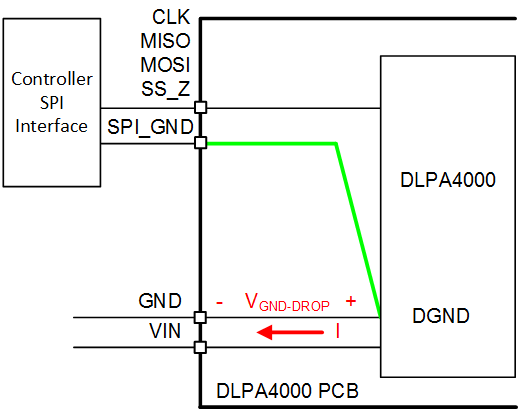DLPS132 May 2018 DLPA4000
PRODUCTION DATA.
- 1 Features
- 2 Applications
- 3 Description
- 4 Revision History
- 5 Pin Configuration and Functions
- 6 Specifications
-
7 Detailed Description
- 7.1 Overview
- 7.2 Functional Block Description
- 7.3
Feature Description
- 7.3.1 Supply and Monitoring
- 7.3.2 Illumination
- 7.3.3 External Power MOSFET Selection
- 7.3.4 DMD Supplies
- 7.3.5 Buck Converters
- 7.3.6 Auxiliary LDOs
- 7.3.7 Measurement System
- 7.4 Device Functional Modes
- 7.5 Programming
- 7.6 Register Maps
- 8 Application and Implementation
- 9 Power Supply Recommendations
- 10Layout
- 11Device and Documentation Support
- 12Mechanical, Packaging, and Orderable Information
Package Options
Mechanical Data (Package|Pins)
- PFD|100
Thermal pad, mechanical data (Package|Pins)
- PFD|100
Orderable Information
10.1.3 SPI Connections
The SPI interface comprises several digital lines and the SPI supply. Communication errors can occur if interface lines are not routed properly. Prevent interference on the SPI lines by placing noisy and interfering sources away from the interface.
Prevent noise by routing the SPI ground line with the digital lines to the respective pins as much as possible. Connect the SPI interface with a separate ground connection to the DGND pin of the DLPA4000 device. This design style prevents ground noise between SPI ground references of DLPA4000 and DLPC due to the high current in the system.
 Figure 31. SPI Connections
Figure 31. SPI Connections
Separate interfering sources from the interface lines. For example, high-current lines such as those near the PWR_7 pin and the SPI_CLK pin are too close, false clock pulses and communication errors can occur.